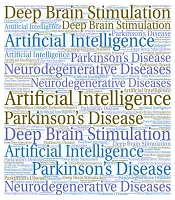1. Context
Over the past few years, the possibilities for using technology to modify or affect brain signals, human behavior, and patient treatments have multiplied. However, techniques that lead to deep brain stimulation (DBS) have always been of interest (1). A common method for DBS is using electrodes that are stereotactically implanted into the subthalamic nucleus (STN) and the globus pallidus internus (Gpi). Following FDA and Conformité Européenne approval, DBS is frequently recommended for the treatment of movement disorders such Parkinson’s disease (PD), tremor, and dystonia, pain syndromes, and has now become the norm of care for these illnesses (2, 3).
Currently, continuous high-frequency stimulation is one of the methods used in DBS that has therapeutic benefits. In this method, a trained clinician applies these frequencies during programming sessions. Although this method has many advantages, it causes side effects in the patient. So, optimizing these programs is very important in clinical treatments. Artificial intelligence (AI) is one of the valuable tools for follow-up after DBS and improving its application programs. Combining DBS with AI creates another research field called intelligent adaptive deep brain stimulation (iDBS). In this review, we investigate the uses of AI for DBS (4-6).
Artificial intelligence is the science of creating computers and robots that both mimic and exceed humans. Artificial intelligence-enabled programs can be used to analyze and contextualize data for providing and extracting new information from previous data without human interference (7). Many different technologies, including in medicine, are based on AI, such as image processing, patient care, clinical decision support tools, disease detection, drug screening, and development, etc. (8). Machine learning (ML) is a computer analysis subfield of AI that uses algorithms to learn insights and extract patterns from data and then uses these patterns to make increasingly better decisions about new information. Also, deep learning is a subfield of ML, at the heart of which is an artificial neural network (9).
Traditionally, computer algorithms consist of codes to interpret data and make decisions. Indeed, ML employs these algorithms to extract the relationships in the data that lead to output and then uses them to convert the new input into an output, which is called “learning”. Machine learning algorithms are typically divided into two subtypes: Supervised learning and unsupervised learning. In supervised learning, the algorithm seeks to find a model of inputs to outputs (10). The model modifies its weights as input data are fed into it until the model has been properly fitted and error has been sufficiently minimized, which takes place as part of the cross-validation process. There are various methods for learning, such as neural networks, naive Bayes, linear regression, logistic regression, support vector machine (SVM), K-nearest neighbor, and random forest. Typically, R and Python programs are used for ML (11). Unlike supervised learning, unsupervised learning does not use labeled data to obtain models. Instead, models decipher the provided data to reveal hidden patterns and insights. Some unsupervised learning algorithms include Gaussian mixture models, hierarchical, K-means, K-nearest neighbors, anomaly detection, neural networks, principal component analysis, independent component analysis, Apriori algorithm, and singular value decomposition (12, 13).
In recent years, the role of DBS in improving PD patients has been well defined. Despite the success of DBS, there are several important questions in this regard, including which patient is suitable for this treatment. Which area of the brain should be stimulated? What are the side effects of this procedure for each patient? Therefore, in this review, we examine not only the role of AI in DBS but also in other stages of PD diagnosis and treatment (14).
2. Methods
2.1. Image Processing and Prediction
Image processing is a technique for applying various procedures to an image to improve it or extract some relevant information from it. It is a signal processing where the input is an image, and the output can either be another image or features or characteristics related to that image (15). It is a primary subject of research in the fields of engineering, computer science, and medicine as well. The role of image processing in medicine is well established (16, 17). However, here we mention the role of this technique in the diagnosis of PD and its treatment.
Magnetic resonance imaging (MRI) and especially functional magnetic resonance imaging (fMRI) and computerized tomography (CT) of the brain are used to diagnose many degenerative diseases (18). Accurate processing of these images can provide markers that lead to early diagnosis of diseases such as Alzheimer’s disease and PD. Moreover, image processing of fMRI can be used to predict optimal stimulation settings in DBS for individual patients because the success of DBS is critically dependent on recognizing the best location within the subthalamic nucleus (the subthalamic nucleus is the hub in the motor circuit that is the most common target in DBS-PD). Also, fMRI can be used to identify a reproducible pattern of brain response to optimal DBS stimulation and then its basis for the prediction of brain response by ML algorithms (19).
2.2. Programming of Deep Brain Stimulation
Many factors affect the success of DBS, including candidate selection, accurate placement of electrodes, and programming process. The selection of patients depends on age, disease stage, and responsiveness to common medication, such as levodopa (20). On the other hand, there is no specific guideline for programming DBS, and it generally is performed by movement disorder neurologists, neurosurgeons, nurses, etc. Therefore, using AI, especially ML, to extract parameters and predict the appropriate program for each patient can play an essential role in improving them (21). Deep brain stimulation programming is complicated due to a large number of possible stimulation configurations, as other patient-dependent variables, such as electrode placement, affect the amount of stimulation (22, 23).
Visualizing the spatial extent of direct neuronal activation is an important factor in assisting in programming DBS devices after external electrical stimulation called volume of tissue activated (VTA). Therefore, by using VTA, we can determine the areas of the brain that are affected by DBS. Based on this, VTA visualization systems allow the medical professional to predict various parameters during surgery and thus get an idea of the configuration required to achieve the desired therapeutic outcome. Interestingly, AI is used to process this information and obtain the appropriate model (24, 25).
2.3. Care After Deep Brain Stimulation
Care of patients and their regular monitoring after DBS is one of the essential points in its programming (26). In recent years, telemedicine has received much attention in the healthcare of patients with PD after DBS. There are different types of home healthcare services based on AI, such as electronic visit verification, remote patient monitoring tools, virtual reality, internet of medical things, telehealth, chatbots, and electronic health records (27, 28). Moreover, wireless technology has been developed to track patients after BDS that can monitor a patient’s movement and gait speed. So, it can be used to evaluate the severity and progression of the disease and the patient’s response to medication. The researchers conducted a one-year study at home using these tools. They showed that a physician could more effectively track PD progression and treatment response by ML algorithms to interpret vast amounts of data that they have passively collected. These data may be used for future DBS reprogramming (29).
3. Conclusions
Parkinson’s disease is the fastest-progressing neurological disease, affecting more than 10 million people worldwide. However, there are considerable challenges in diagnosing, treating, and tracking its severity and progression. Deep brain stimulation is one of the treatment methods for PD that has been of interest for decades. Many variables affect the result of this treatment method, which has been reduced in recent years with the advancements of artificial intelligence, and its results are predictable. Technology will reach the point where we can diagnose or predict disease at home. In the future, we may even be able to use AI to predict PD based on changes in a person’s movements.



.png)